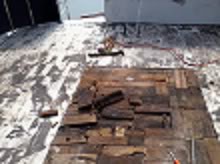Good info folks. I have a 36' Universal, and my upper deck is visually OK, but the aft/port corner is springy, and water seeps inside along the wall, down along the overhead, and into the aft cabin where it drips right onto the bed (of course).
My plan is to take up the teak, working from aft fwd to the benches - about half way. Then I'll use a precision rotaray saw to remove the glass. I expect the entire core to be rotten, so once that is removed I've been told to lay down some sheets of insulation, then plywood, then epoxy the snot out of everything before I re-glass. The fiberglass will most likely be done by a professional. Then I'm going to simply apply some rubberized non-skid.
The trouble is keeping the upper deck dry, as I'm in Ketchikan. I think I might shrink wrap the whole
I'll take any advice anyone might have.

